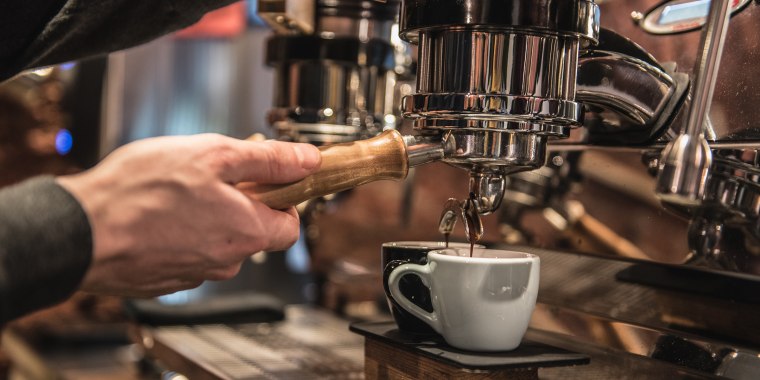What does it take to brew a perfect coffee drink?
According to scientists and mathematicians from the U.S., the U.K., Australia and Switzerland, a lot of people — even baristas — have been making espresso incorrectly for years.
A study published this week in the academic journal Matter sought to uncover the best way to brew espresso given that the end result varies widely based on how it's made. The conclusion? Fewer coffee beans ground coarsely are key. This runs contrary to many techniques that advise grinding beans more finely to achieve greater surface area.
"A good espresso beverage can be made in a multitude of ways," said study co-author Christopher Hendon, a computational chemist at the University of Oregon. "The point of this paper was to give people a map for making an espresso beverage that they like and then be able to make it 100 times in a row."
An espresso that uses fewer beans will not only save consumers and coffee shop owners money in the long run, but the scientists maintain that espresso brewed in this way will be more consistent from shot to shot, and still have a finish that's just as strong as traditional methods.
Previously, the practice of grinding beans finely (usually to the texture of table salt), was thought to allow more coffee to dissolve in water, resulting in a stronger brew. Not so, say the scientists.
"Most people in the coffee industry are using fine-grind settings and lots of coffee beans to get a mix of bitterness and sour acidity that is unpredictable and irreproducible," said Hendon. "It sounds counterintuitive, but experiments and modeling suggest that efficient, reproducible shots can be accessed by simply using less coffee and grinding it more coarsely."
The scientists believe there’s a fine (pun intended) line here, and found that when coffee is ground too finely, the basket of the espresso maker that holds the bean (known as the coffee bed) can get clogged, which actually means less, not more, coffee is extracted from the beans.
"If you use 15 grams (1 tablespoon) instead of 20 grams (1 1/3 tablespoons) of coffee and grind your beans coarser, you end up with a shot that runs really fast but tastes great," said Hendon.
This measurement system uses fewer grounds per serving than Starbucks, for example, which recommends using 2 tablespoons of grounds per shot of espresso.
"We suggest novel brewing protocols that not only reduce beverage variation but also decrease the mass of coffee used per espresso by up to 25%," said the study authors. "If widely implemented, this protocol will have significant economic impact and create a more sustainable coffee-consuming future."
Some professional baristas are already getting on board with the research.
After attending a talk Hendon gave at the Speciality Coffee Association Expo, barista Andreas Willhoff, former manager of Wormhole Café in Chicago and a consultant on the book "Craft Coffee: A Manual," told TODAY that he began experimenting with coarser grounds and different water ratios.
"I brought this information back to Chicago with me and, together with my staff trainer, hunkered down in our training lab in the Wormhole basement," Willhoff said. "We pulled (barista terminology for making espresso on a machine) a ton of shots, and there was a point where I wasn't quite sure it would work. It requires letting go of a lot of biases and trusting your sense of taste, which is kind of hard to rewire!”
Willhoff even held a blind taste test among his staff members with espresso made in different ways.
“When they started critiquing the shot in the same way they would critique any shot, I figured we were onto something,” he said. “You would think that the shots (made with the new technique) would lack body, but that wasn't the case. The shots were a little more delicate the others, but the increased amount of perceived sweetness made up for that change in ratio."
Wormhole Cafe now utilizes Hendon's method for all espresso drinks.
Of course, many pros will also say that crafting a great cup of coffee is truly an art, not a science, so even a supposedly foolproof scientific ratio will not always work for every barista or home coffee maker.
“The best extraction practices are extremely dependent on the origin of the coffee bean," Adam Budnick, a barista at Kettner Coffee Supply in Nashville, told TODAY. "This includes the presence of lactic acid based on elevation, fermentation of the coffee bean husk or cherry and how the washing process affects the available sugars."
The bottom line? Professional baristas will always be experimenting with their bean-to-water ratios, but home brewers looking to save a little cash on their coffee habit and cut down on potential food waste should give the Hendon hack a try.


